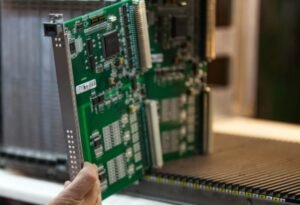Artificial Intelligence or Machine Learning
Artificial Intelligence (AI) and Machine Learning (ML) are two popular terms often used interchangeably, but they are distinct fields of study with different applications and objectives.
Key Takeaways:
- AI focuses on creating smart machines capable of simulating human intelligence.
- ML is a subset of AI and involves training machines to learn from data and improve their performance.
- Both AI and ML have a wide range of applications in various industries.
- AI requires complex algorithms and vast amounts of data to function effectively.
- ML algorithms can be supervised, unsupervised, or semi-supervised.
Understanding Artificial Intelligence
Artificial Intelligence refers to the development of computer systems or machines that can perform tasks requiring human intelligence, such as speech recognition, decision-making, problem-solving, and understanding natural language. AI systems aim to simulate human intelligence and provide intelligent solutions to complex problems. These systems can operate in real-time and adapt to changing circumstances.
One interesting aspect of AI is the concept of machine consciousness, where machines possess self-awareness and exhibit human-like cognitive abilities.
Machine Learning: A Subset of AI
Machine Learning is a subset of AI that focuses on enabling machines to learn from data without being explicitly programmed. ML algorithms learn patterns and relationships from the provided data and use this knowledge to make accurate predictions or decisions. ML is widely used in various domains, including healthcare, finance, marketing, and autonomous vehicles.
An intriguing aspect of ML is its ability to discover hidden patterns and insights from vast amounts of data that may not be apparent to humans.
Supervised vs. Unsupervised Learning
There are different types of ML algorithms, including supervised, unsupervised, and semi-supervised learning.
| Algorithm Type | Description |
|---|---|
| Supervised Learning | Uses labeled data to train models and make predictions based on known examples. |
| Unsupervised Learning | Uses unlabeled data to discover patterns and relationships without prior knowledge. |
| Semi-supervised Learning | Combines both labeled and unlabeled data to train models, combining the benefits of both approaches. |
Applications of AI and ML
AI and ML have a wide range of applications across various industries:
- Healthcare: AI can assist in disease diagnosis, drug discovery, and personalized medicine.
- Finance: ML algorithms can analyze large datasets to detect fraud, predict market trends, and automate trading.
- Marketing: AI can enhance customer targeting, optimize advertising campaigns, and personalize user experiences.
Comparing AI and ML
Let’s compare AI and ML in a side-by-side comparison:
| Artificial Intelligence (AI) | Machine Learning (ML) |
|---|---|
| Focuses on simulating human intelligence. | Focuses on training machines to learn from data. |
| Requires complex algorithms and vast amounts of data. | Utilizes various ML algorithms to process data. |
| Can operate in real-time and adapt to changing circumstances. | Improves performance by learning from data. |
The Future of AI and ML
The field of AI and ML continues to expand, with ongoing research and advancements driving innovation across industries. As technology progresses, we can expect AI and ML to revolutionize numerous aspects of our lives, making tasks more efficient, providing intelligent solutions, and transforming industries.

Common Misconceptions
Artificial Intelligence (AI)
One common misconception about AI is that it is capable of human-like reasoning. In reality, AI systems are based on algorithms and statistical models and do not possess human cognitive abilities.
- AI cannot think or understand like humans.
- AI cannot feel emotions or have consciousness.
- AI is limited to the tasks it has been trained for and cannot generalize outside specific domains.
Machine Learning (ML)
Another common misconception is that ML algorithms are infallible and always provide accurate results. However, ML models are prone to errors and biases, often reflecting the quality of the data they are trained on.
- ML algorithms are only as good as the data they are trained on.
- ML models can have biases and may produce unfair or discriminatory outcomes.
- ML models require constant monitoring and updating to maintain their accuracy and usefulness.
AI replacing Human Jobs
One misconception is that AI will eliminate significant numbers of human jobs. While AI may automate certain tasks, it also creates new roles and opportunities in various industries.
- AI can augment human capabilities and improve productivity in many fields.
- AI-driven automation is more likely to reshape jobs than entirely replace them.
- New industries and job roles will emerge as AI technology advances.
AI and ML being the Same
Many people confuse AI and ML, assuming they are interchangeable terms. Although ML is a subset of AI, the two represent different aspects of the broader field of artificial intelligence.
- AI encompasses a wide range of techniques and approaches, including ML.
- ML focuses on training algorithms to learn patterns and make predictions from data.
- AI includes other components like natural language processing, computer vision, and expert systems.
AI as a Threat to Humanity
There is a misconception that AI poses an immediate threat to humanity, often fueled by sensationalized portrayals in movies and media. While ethical considerations are important, the development of AI is guided by human control and responsibility.
- AI development includes ethical frameworks to ensure responsible use and minimize risks.
- Robust regulations and oversight are in place to prevent AI from becoming a danger to society.
- AI technology can be used for positive purposes like healthcare, environmental conservation, and scientific research.

The Rise of Artificial Intelligence
Artificial Intelligence (AI) has rapidly transformed various industries and is becoming a fundamental part of our daily lives. This article explores ten fascinating aspects of AI and machine learning, showcasing their impact and potential.
Growth in AI Funding
Investment in AI technology has skyrocketed in recent years, indicating the growing importance and potential of this field. In 2019 alone, global AI funding reached a staggering $26.6 billion.
Job Market for AI Professionals
As AI continues to advance, there is a surging demand for skilled professionals in this field. The job market for AI professionals is predicted to grow by 16% annually, reaching over 11 million jobs by 2025.
AI in Healthcare
Artificial Intelligence is revolutionizing the healthcare sector, improving diagnosis accuracy and treatment outcomes. Machine learning algorithms have shown a remarkable ability to detect cancer cells with an accuracy of over 90%.
AI in Autonomous Vehicles
The development of autonomous vehicles heavily relies on AI and machine learning. These technologies enable cars to make decisions, react to their surroundings, and enhance road safety significantly.
AI in Financial Fraud Detection
Financial institutions are using AI algorithms to detect and prevent fraud more effectively. Machine learning models examine vast amounts of data, identifying patterns that are indicative of fraudulent activities with astonishing accuracy.
AI in Natural Language Processing
Natural Language Processing (NLP) has dramatically improved with the aid of AI, enabling computers to understand and interpret human language. Chatbots and voice assistants are prime examples of AI-driven NLP applications.
AI in Gaming
AI has transformed the gaming industry, enhancing the realism of virtual worlds and creating more challenging opponents. Deep Reinforcement Learning algorithms enable game characters to learn and adapt their strategies based on player behavior.
AI in Weather Forecasting
Weather forecasting has significantly improved with AI algorithms that analyze vast amounts of meteorological data. Neural networks and machine learning models can predict weather patterns with greater accuracy, aiding disaster preparedness and response.
AI in Sustainable Energy
AI technologies play a pivotal role in optimizing energy consumption and promoting sustainable practices. Smart grids powered by AI systems can forecast energy demand, help balance supply and demand, and reduce wastage.
AI in Personalized Marketing
AI-driven marketing algorithms enable companies to deliver highly personalized content and recommendations to consumers. These systems analyze vast amounts of data, maximizing customer engagement while improving sales efficiency.
Innovations in artificial intelligence and machine learning continue to shape the world we live in. From advanced healthcare applications to enhancing customer experiences, AI has vast potential for further development and integration. As we move forward, harnessing AI’s power responsibly and ethically will be crucial to benefitting from its transformative capabilities.
FAQs – Artificial Intelligence and Machine Learning
What is artificial intelligence?
What is machine learning?
How does artificial intelligence work?
What are the applications of artificial intelligence?
Are artificial intelligence and machine learning the same?
Can artificial intelligence replace human jobs?
What are the ethical considerations surrounding artificial intelligence?
How does machine learning train models?
What are the different types of machine learning?
What are the challenges of implementing machine learning?




